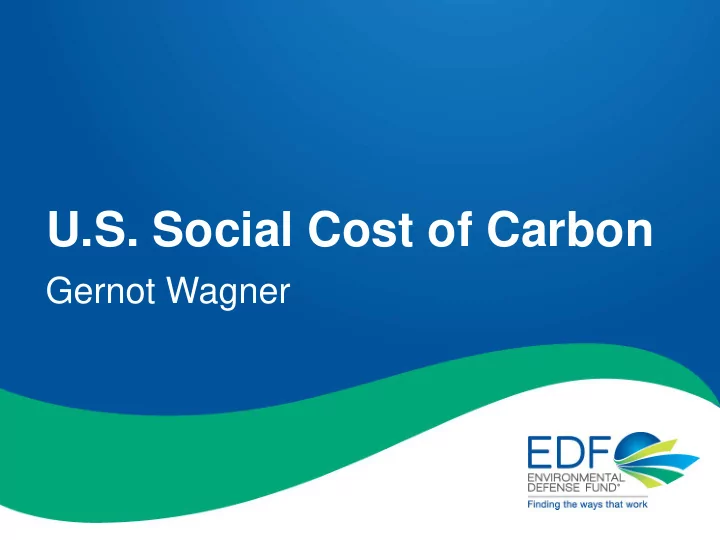

U.S. Social Cost of Carbon Gernot Wagner
* Forthcoming late 2014/ early 2015, Princeton University Press
$40
Large differences in Social Cost estimates All > –$15, given $500 billion in global fossil fuel subsidies Source: Scott Barrett, Economics of Energy guest lecture, Columbia, November 2013.
Social Cost used in >20 U.S. federal rules since 2010 Each regulatory use provides opportunity for public comments e.g. • Energy Conservation Standards for Standby Mode and Off Mode for Microwave Ovens, 77 Fed. Reg. 8526 (Feb. 14, 2012) • Energy Conservation Standards for Residential Dishwashers, 77 Fed. Reg. 31,964 (May 30, 2012) • Greenhouse Gas Emissions Standards and Fuel Efficiency Standards for Medium- and Heavy-Duty Engines and Vehicles, 75 Fed. Reg. 74,152 (Nov. 30, 2010) … • Proposed Carbon Pollution Standards for New Power Plants (Nov. 20, 2013) • Upcoming Carbon Pollution Standards for Existing Power Plants Office of Management and Budget initiated additional comment period Source: EDF et al . Comment on Technical Support Document: Technical Update of the Social Cost of Carbon for Regulatory Impact Analysis under Executive Order No. 12,866. (February 26, 2014).
~$40 revised November 2013 Social Cost of CO 2 Small correction to May 2013 revision; e.g. $37 down from $38. All in 2007 US$. Significant increase over 2010 figures: $37 up from $24 Source: “Technical Update of the Social Cost of Carbon for Regulatory Impact Analysis Under Executive Order 12866” (November 1, 2013).
2013 Social Cost up due to new model versions Core assumptions all remained unchanged from 2010 Interagency Working Group Update includes damages from sea level rise Source: “Technical Update of the Social Cost of Carbon for Regulatory Impact Analysis Under Executive Order 12866” (November 1, 2013).
Large distribution of Social Cost estimates Social Cost of Carbon in 2020 (in 2007 US$) Social Cost of Carbon in 2020 [2007$] Source: “Technical Update of the Social Cost of Carbon for Regulatory Impact Analysis Under Executive Order 12866” (November 1, 2013).
Discount rate and damage functions drive (almost) all*
Shape of damage function critical for Social Cost Large divergence for temperatures increases >5°C above pre-industrial DICE et al assume ~quadratic damage function Source: Wagner & Weitzman’s Climate Shock (forthcoming)
Would need to know damage distribution at each Δ °C Current practice of extrapolating from small Δ °C – using quadratic function – inadequate Final Δ °C 2°C 2.5°C 3°C 3.5°C 4°C 4.5°C 5°C 5.5°C 6°C Ave. damages 1% 1.5% 2% 3% 4% ? ?? ??? ???? as % of GDP Prob >50% ???% ???% ???% ???% ???% ???% ???% ???% ???% damages Quadratic extrapolation of damages likely underestimate Source: Wagner & Weitzman’s Climate Shock (forthcoming)
Critical issues for Social Cost updates Re-running 3 models with 2010 assumptions routine update, but only first step • Declining discount rate • Updated damage functions • Damages as % of growth vs % of levels • Additive vs multiplicative damages • Revisit model selection (DICE, FUND, PAGE; CRED?, ENVISAGE?) • Update assumptions to IPCC Shared Socioeconomic Pathways • “IBM-ify” Social Cost calculations “Good job. More can and must be done.” Source: EDF et al . Comment on Technical Support Document: Technical Update of the Social Cost of Carbon for Regulatory Impact Analysis under Executive Order No. 12,866. (February 26, 2014); and Wagner & Weitzman ‘s Climate Shock (forthcoming)
* Forthcoming late 2014/ early 2015, Princeton University Press
It’s not over ‘til the fat tail zings Rapidly increasing probability of extreme final temperatures By 2100, per IEA’s “New Policies Scenario” CO 2 e (ppm) 400 450 500 550 600 650 700 750 800 Median Δ °C 1.3°C 1.8°C 2.2°C 2.5°C 2.7°C 3.2°C 3.4°C 3.7°C 3.9°C <1.5x 10x Prob >6°C 0.04% 0.3% 1.2% 3% 5% 8% 11% 14% 17% 10x 10x Analysis beyond standard benefit-cost analysis (and, thus, Social Cost)? Source: Wagner & Weitzman’s Climate Shock (forthcoming)
Gernot Wagner gwagner@edf.org gwagner.com
Recommend
More recommend